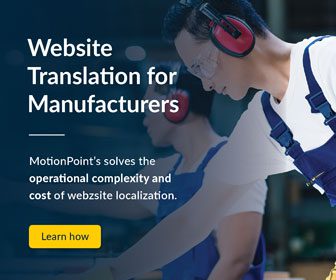Pricing becomes an increasingly important factor as you narrow your choice for a website translation solution. But smart buyers know that “price” is about more than costs. You must seek to understand why a vendor charges what it does:
- What’s included? What’s extra?
- Is there potential for a vendor to mislead you on pricing?
- Will the vendor put its own interests ahead of yours?
Unlike many of our competitors, MotionPoint's pricing model is equitable and customer-friendly. Read on to learn how other companies do business-and how MotionPoint is different.
Smart buyers know that 'price' is about more than costs. They seek to understand why a vendor charges what it does.
The Shortsighted Approach
Some translation vendors hide the full cost of translation behind absurdly low price-per-word pricing schemes. Others implement price-per-page view models that essentially penalize customers for being successful in global markets. Let's take a closer look at these wrongheaded pricing models.
Low Price-Per-Word Costs
The price-per-word pricing model—in which projects are largely defined by how many translatable words are within the project’s scope—is common for translation projects of all kinds.
At first glance, it appears to be a fair way to determine website localization costs. But not all vendors are created equal. Traditional agencies may shave pennies off their per-word rates to woo prospective customers, or to compete on price-but they make up any revenue losses by charging extra for editorial review, revisions, QA and project management.
These agencies also often charge to translate identical content more than once, or apply fees to republish previously-translated content. This is not a best practice.
Indeed, when vendors’ profits hinge almost solely on revenue generated by translation, they’re not motivated to use technologies in smart ways to reduce your project’s translatable word count. If anything, they’re inclined to maximize your translation spend, not minimize it.
Many vendors incorporate hidden fees to offset low price-per-word rates.
Also, website translation is a unique beast. Translatable content resides in webpages, videos, images, and complex applications powered by AngularJS and other programming languages. Undercooked translation technologies do a bad job of detecting this content, resulting in low—and very inaccurate—word count estimates.
When combined with a low price-per-word cost, this becomes a recipe for lowball quotes and unexpected expenses down the road, when previously-undetected translatable content is finally discovered.
Price-Per-Page View
Other proxy translation vendors use a “price-per-page view” model. They beguile customers with free trials and low monthly subscription fees.
But that subscription fee only covers a certain number of translatable words. And there are often charges for additional translation, editing services, project management, additional connector integrations, and more.
They also heap on more charges, based on how many page views a localized site generates each month. This means the more successful your brand is in-market, the more traffic your translated site generates, and the more you're charged by the vendor.
You're penalized for being prosperous. That doesn't make sense.
A price-per-page model essentially punishes you for being successful. That's not fair.
A Better Approach
MotionPoint does things differently. We don't nickel-and-dime customers with hidden costs, and we don't penalize you for growing and succeeding in global markets. Our model was designed to be customer-friendly and align with your business goals. Here's how we do it right:
Industry Leading Content-Detection Technology
MotionPoint uses the most sophisticated scoping technology in the industry, enabling us to give customers accurate word-count estimates for the scope of work.
Simple Pricing
Our flat subscription fee covers the technology and support that ensures the ongoing operation of your site. This includes, but isn't limited to:
Managed Hosting Solutions: Hosting solutions ensure 99.9% uptime while eliminating any management or effort on your end
24 /7 / 365 Support: You get access to project managers, software and system engineers, QA, and other support teams any day, any time.
Access to Translation Memory and Microservices: You can retrieve previously-translated content at any time via our API or user interface at no extra cost, and access other statistics about your multilingual websites.
Automatic Detection of New or Updated Content: Our industry-leading change-detection technology delivers fast translation workflows—typically within one business day.
That's it. No fine print. Beyond that, we charge for any new words we translate each month.
All-Inclusive Per-Word Pricing
Our per-word rate includes translation of the content, as well as a multi-step editorial review process, including a “live view” QA to ensure the translated pages look great before they’re published.
No Page-View Based Pricing
We never punish you for being popular. Our subscription covers unlimited traffic. The more traffic your translated site gets, the more valuable MotionPoint's solution becomes.
Industry-Exclusive Translation Engineering
Unlike other vendors, we don't use a standard "one-size-fits-all" parsing algorithm. Our team of Translation Engineers optimizes the parsing based on your site's unique configuration, finding the best way to save you money.
MotionPoint’s pricing model is designed to be customer-friendly, and align with your business goals.
Conclusion
When considering a translation vendor, carefully examine its pricing model. A price that looks too good to be true almost always is.
MotionPoint never blindsides you with lowball quotes, hidden costs or extra fees. Our business model is to provide operational efficiency, cost savings, speed to market, and flawless performance, so that you can keep adding languages-and expanding your global reach.
Last updated on October 18, 2017
